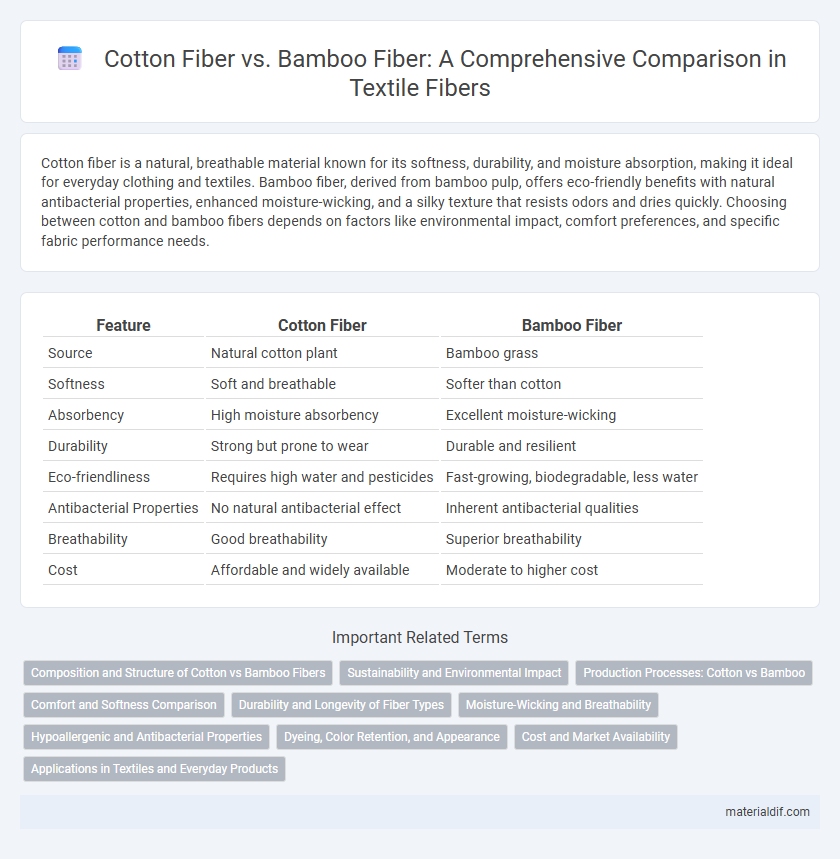Cotton fiber is a natural, breathable material known for its softness, durability, and moisture absorption, making it ideal for everyday clothing and textiles. Bamboo fiber, derived from bamboo pulp, offers eco-friendly benefits with natural antibacterial properties, enhanced moisture-wicking, and a silky texture that resists odors and dries quickly. Choosing between cotton and bamboo fibers depends on factors like environmental impact, comfort preferences, and specific fabric performance needs.
Table of Comparison
| Feature | Cotton Fiber | Bamboo Fiber |
|---|---|---|
| Source | Natural cotton plant | Bamboo grass |
| Softness | Soft and breathable | Softer than cotton |
| Absorbency | High moisture absorbency | Excellent moisture-wicking |
| Durability | Strong but prone to wear | Durable and resilient |
| Eco-friendliness | Requires high water and pesticides | Fast-growing, biodegradable, less water |
| Antibacterial Properties | No natural antibacterial effect | Inherent antibacterial qualities |
| Breathability | Good breathability | Superior breathability |
| Cost | Affordable and widely available | Moderate to higher cost |
Composition and Structure of Cotton vs Bamboo Fibers
Cotton fiber is primarily composed of cellulose with a linear structure that provides softness and breathability, featuring a hollow, twisted ribbon-like shape that enhances moisture absorption. Bamboo fiber, also mainly cellulose-based, contains natural antimicrobial components like bamboo kun and has a more porous, micro-grooved structure that improves ventilation and moisture-wicking properties. The molecular arrangement in bamboo fibers results in higher tensile strength and durability compared to the more delicate, smooth surface of cotton fibers.
Sustainability and Environmental Impact
Cotton fiber production requires significant water consumption and pesticide use, leading to soil degradation and high carbon emissions. Bamboo fiber offers a more sustainable alternative due to rapid growth, low water needs, and natural pest resistance, reducing agricultural environmental impact. Bamboo's biodegradability and lower chemical processing enhance its eco-friendliness compared to conventional cotton.
Production Processes: Cotton vs Bamboo
Cotton fiber production involves harvesting cotton bolls followed by ginning to separate fibers from seeds, then spinning into yarn, relying heavily on water and pesticide use. Bamboo fiber production starts with harvesting bamboo stalks, which are mechanically crushed or chemically processed to extract cellulose fibers, often using environmentally intensive methods like the viscose or lyocell process. Bamboo's production can be more sustainable if utilizing closed-loop systems that recycle chemicals, contrasting with conventional cotton's high resource consumption and environmental impact.
Comfort and Softness Comparison
Cotton fiber is known for its natural breathability and softness, providing a gentle touch against the skin ideal for everyday wear. Bamboo fiber outperforms cotton in moisture-wicking properties, with a smoother texture that enhances comfort and reduces irritation, making it suitable for sensitive skin. Both fibers offer softness, but bamboo's hypoallergenic and antimicrobial qualities contribute to a cooler, more comfortable experience in warm or humid conditions.
Durability and Longevity of Fiber Types
Cotton fiber offers moderate durability with natural breathability but tends to weaken and lose strength after repeated washing and exposure to sunlight. Bamboo fiber exhibits superior longevity due to its inherent antimicrobial properties and higher tensile strength, maintaining its integrity over time even with frequent use. While both fibers provide comfort, bamboo fiber's durability makes it a preferred choice for long-lasting textiles and sustainable fashion.
Moisture-Wicking and Breathability
Cotton fiber is highly breathable and excels at moisture-wicking by absorbing sweat, keeping the skin dry and comfortable during moderate activities. Bamboo fiber outperforms cotton in moisture management due to its porous structure, which facilitates quicker evaporation and superior breathability. Both fibers offer natural moisture-wicking properties, but bamboo fiber is particularly advantageous in high humidity or intense exercise conditions.
Hypoallergenic and Antibacterial Properties
Cotton fiber is naturally hypoallergenic, making it ideal for sensitive skin and reducing the risk of irritation or allergic reactions. Bamboo fiber possesses inherent antibacterial properties due to the presence of bamboo kun, a bio-agent that inhibits bacterial growth and odor. Both fibers offer distinct benefits for hypoallergenic and antibacterial applications, with bamboo fiber providing enhanced microbial resistance while cotton ensures gentle skin compatibility.
Dyeing, Color Retention, and Appearance
Cotton fiber exhibits strong dye affinity, resulting in vibrant colors that maintain moderate retention over time, but it can fade with frequent washing and sunlight exposure. Bamboo fiber displays excellent color retention due to its smooth surface and natural antibacterial properties, which help preserve dye integrity and reduce color fading. The appearance of cotton fiber is soft and matte, while bamboo fiber offers a silky sheen and smoother texture, enhancing the overall visual appeal of dyed fabrics.
Cost and Market Availability
Cotton fiber generally costs more than bamboo fiber due to its extensive cultivation and processing requirements, driving higher demand and price points in global markets. Bamboo fiber offers a cost-effective alternative with its rapid growth cycle and sustainable harvesting methods, making it increasingly available, especially in Asian and eco-conscious markets. Market availability of cotton remains dominant worldwide, supported by established supply chains, whereas bamboo fiber is gaining traction as a niche product in sustainable fashion and home textiles.
Applications in Textiles and Everyday Products
Cotton fiber is widely used in textiles for its softness, breathability, and moisture-absorbing properties, making it ideal for clothing, bed linens, and towels. Bamboo fiber is favored for its natural antibacterial qualities, durability, and eco-friendly production, commonly found in activewear, socks, and reusable hygiene products. Both fibers contribute to sustainable fashion, with cotton dominating traditional fabrics and bamboo gaining popularity in innovative, performance-oriented textiles.
Cotton Fiber vs Bamboo Fiber Infographic

 materialdif.com
materialdif.com